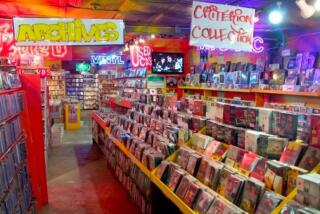VIDEO CASSETTE PLAYER CRAZE STRIKES U.S.S.R.
MOSCOW — It all started when video recorders began to filter in from the West, commanding a high price on the black market and forcing Soviet manufacturers to put their own version of the VCR in local stores.
So it was inevitable that a domestic and ideologically pure source for the growing video market would also appear to feed the market subsisting on contraband movies smuggled in from the West.
In November two video rental stores opened in Moscow, heralding the beginning of a new consumer craze.
The new stores not only signal that VCRs have caught on, but that they are viewed by the hard-headed authorities as a legitimate form of entertainment, one that can replace a more traditional Soviet pastime: drinking vodka.
Popular Demand
For more than a year there have been signs in the state-run press that the popular demand for VCRs, which hit the West a few years ago, would be met.
It’s not that authorities want to encourage consumerism, but, with the harsh restrictions placed on alcohol consumption last summer (sales limited daily to a 5-hour period in what remain of the nation’s liquor stores), Soviet money and time have to be channeled in new directions.
The video concept seems to be catching on. On a cold and snowy afternoon, a crowd of people stood thawing in the lobby of the new Moscow video salon, craning to see the list of available films.
“We have used the store quite a bit,” said one contented renter, who owns a Western-made VCR. He said he first read about the store in the newspaper Soviet Culture, which reported the opening Nov. 12.
Rental Stores
According to Soviet Culture, video rental stores have also opened in Voroneszh, Minsk, Vilnius, Rostov and Leningrad. The small town of Voroneszh, 250 miles south of Moscow, was a logical choice since Soviet VCR production began there early in 1984.
So far the factory has produced only a few thousand machines for a population of 280 million, compared to 15 million machines in use in America by the end of 1984.
Despite the shortage and the growing demand, the domestic VCR is largely ignored because of a $1,560 price tag and poor quality.
In April, the Communist youth newspaper Komsomolskaya Pravda said, “at first, about a quarter of the videos was sent straight from the conveyor belt to the repair workshop.”
The newspaper also complained that there was nothing to watch once a lucky Soviet got his hands on a machine.
“Not one single film has been shot specially for video. Only 15 of the films that are available came out after 1980,” Komsomolskaya Pravda said.
Western Machines
The opening of rental stores attests to the number of Soviets with VCRs. Many brought them back after working in the West or resorted to paying between $3,900 to $9,100 for Western machines sold in “used” goods stores.
About 350 films were available at the Old Arbat store. Most were Soviet, though some were East Bloc films. Some played in Moscow movie theaters just last summer. A guard in the salon lobby said with pride that Western films, “even some from the United States,” would be available after Jan. 1.
Films rent for $2 to $4 per day. Given the average monthly salary of $235, that adds up.
More to Read
Sign up for Essential California
The most important California stories and recommendations in your inbox every morning.
You may occasionally receive promotional content from the Los Angeles Times.









